ESSA
Tutor.com Effectiveness Study (2023)
Study Type: ESSA Evidence Level II, Prepared by LearnPlatform by Instructure
Tutor.com Effectiveness Study (2024)
Study Type: ESSA Evidence Level II, Prepared by LearnPlatform by Instructure
Tutor.com Logic Model
Study Type: ESSA Evidence Level IV, Prepared by LearnPlatform
The Princeton Review® Effectiveness Study (2024)
The Princeton Review Logic Model
Study Type: ESSA Evidence Level IV, Prepared by LearnPlatform by Instructure, December 2024
Academic Research
The Hallmarks of High-Quality Tutoring: White Paper
Dr. Danielle Kearns-Sixsmith
The Hallmarks of High-Quality Tutoring: A Higher Ed Study Using MM-GT
Dr. Danielle Kearns-Sixsmith and Jennifer Boller
Case and Efficacy Studies
Trends in Education
 Algebra Trends
Algebra Trends
A White Paper from Tutor.com
June 2023
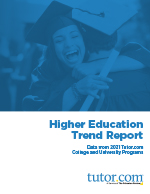 Higher Education Trend Report
Higher Education Trend Report
Data from 2021 Tutor.com College and University Programs
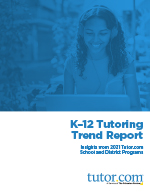 K–12 Tutoring Trend Report
K–12 Tutoring Trend Report
Insights from 2021 Tutor.com School Districts and Programs
Webinars
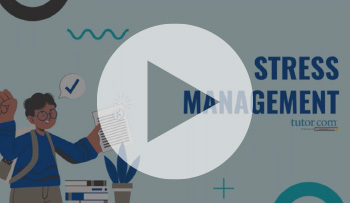 Stress Management
Stress Management
Student Success Webinar Series 2022-23
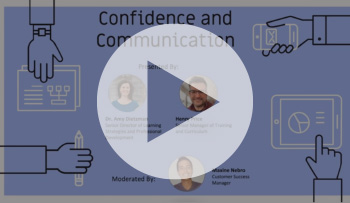 Confidence and Communication
Confidence and Communication
Student Success Webinar Series 2022–23
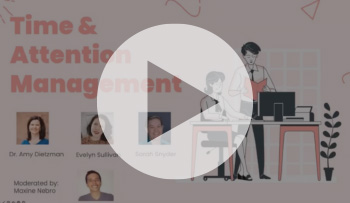 Time and Attention Management
Time and Attention Management
Student Success Webinar Series 2022–23
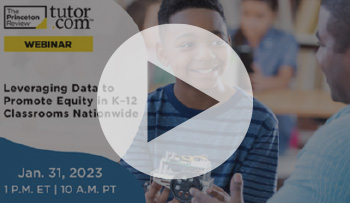 Leveraging Data to Promote Equity in K–12 Classrooms Nationwide
Leveraging Data to Promote Equity in K–12 Classrooms Nationwide
K–12 Leaders Webinar Series 2022–2023
Jan. 31, 2023
 Critical Thinking and Research Skills
Critical Thinking and Research Skills
Student Success Webinar Series 2023
 Becoming a Confident Writer
Becoming a Confident Writer
Student Success Webinar Series 2023
 Collaboration and Teamwork
Collaboration and Teamwork
Student Success Webinar Series 2023
 Navigating the College Decision
Navigating the College Decision
College Readiness and Management for Working Adults Series
Fall 2022
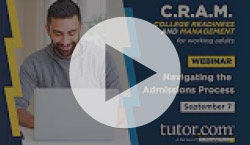 Navigating the Admissions Process
Navigating the Admissions Process
College Readiness and Management for Working Adults Series
Fall 2022
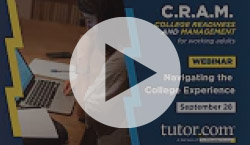 Navigating the College Experience
Navigating the College Experience
College Readiness and Management for Working Adults Series
Fall 2022
 Navigating Life After College
Navigating Life After College
College Readiness and Management for Working Adults Series
Fall 2022
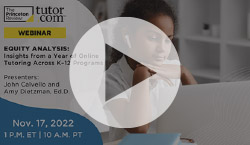 Teacher Shortages and the Achievement Gap
Teacher Shortages and the Achievement Gap
K–12 Leaders Webinar Series
Fall 2022
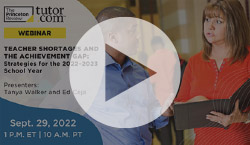 Updates to the College Admissions Process
Updates to the College Admissions Process
K–12 Leaders Webinar Series
Fall 2022
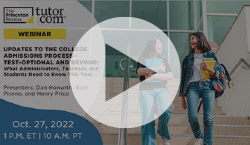 Equity Analysis: Insights from Online Tutoring Across K–12 Programs
Equity Analysis: Insights from Online Tutoring Across K–12 Programs
K–12 Leaders Webinar Series
Fall 2022
 Mastering Your Study Skills (and Note Taking)
Mastering Your Study Skills (and Note Taking)
Student Success Webinar Series 2022
Jan. 21, 2022
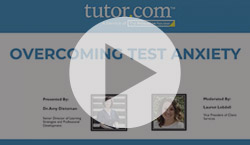 Overcoming Test Anxiety
Overcoming Test Anxiety
Student Success Webinar Series 2022
Feb. 4, 2022
Click here for
Partner Insights
Annotated Bibliography
Bransford, J. D., Brown, A. L., & Cocking, R. R. (2000). How People Learn (Vol. 11). Washington, DC: National Academy Press.
This germinal work is deeply rooted in the core values at Tutor.com. Our tutors do not support rote memorization nor answer-giving, and as Bransford and his team revealed, it is through understanding that we learn. Learning involves building understanding based on existing mental schemata and developing conceptual and procedural knowledge of specific subject topics. Tutors are encouraged to foster this process by engaging through interaction, one-on-one with individual students, as learners seek to better understand the work they are engaged with; most often from the classrooms where they are led by teachers. Tutors do not simply transfer knowledge but rather, take time to access user understanding, introduce and guide through inquiry, and help students apply new connections appropriately in context. This includes acclimating to the individual’s learner style and preferences revealed through the one-on-one interactions. This informs tutors of the needs of the sessions and to adjust using the tools and capabilities available in the online classroom platform. This study also continues to inform current practices as we assess and improve quality of tutoring in sessions and begin developing and disseminating our own evidence for Bransford’s axioms.
Hrastinski, S., Keller, C., & Carlsson, S. A. (2010). Design exemplars for synchronous e-learning: A design theory approach. Computers & Education, 55(2), 652–662.
Hrastinkski et al. (2010) provided important work that initiated conversations and the offering of both asynchronous as well as synchronous online tutoring at Tutor.com. While essays were more commonplace for asynchronous sessions, live or synchronous sessions provide real time questions and answers to support learning that is scaffolded and speaks to learners who prefer the one-on-one engagement (later revealed as social presence in online learning experiences). In less popular asynchronous sessions, such as for STEM-related areas, for example, discussions ensued about answer-giving and implementing practices of providing parallel or example problems to help a learner associate the problems and questions they may be assigned during coursework. The findings from this study supported the Tutor.com philosophy that, “choice of communication media to be dependent on the way in which it can support the educational processes” (Hrastinski, 2010, p.656) for the learner seeking the support.
Dorn, E., Hancock, B., Sarakatsannis, J., & Viruleg, E. (2020). COVID-19 and learning loss—disparities grow and students need help. McKinsey & Company, December 8, 224–228.
As we follow the literature in more recent times; trends and findings of the Covid and post-pandemic educational impacts on education, we aim to heed the call that online tutoring can and should be used to address loss-of-learning across the country. With development to design better platforms for the teachers that recommend online tutoring, we also seek models that will reach the wide diversity of students tasked with learning. This may be high dosage tutoring or small group tutoring and several pilots are ongoing to explore the benefits and consequences for learners and their programs. These findings will inform the next round of development discussions and enhance our tutoring platforms even more.




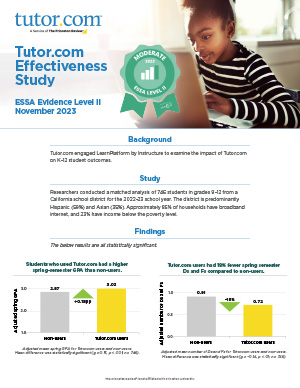 Study Highlights
Study Highlights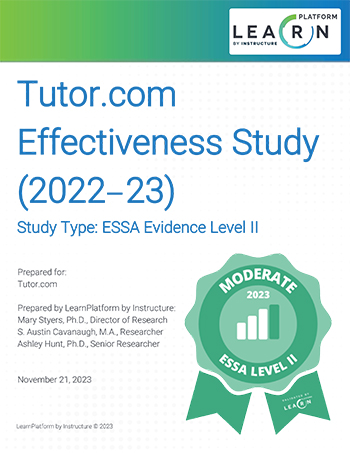 Full Study
Full Study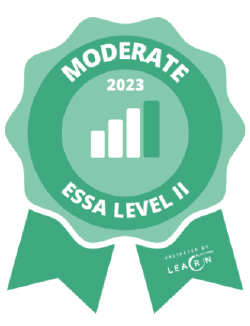 ESSA II Credential
ESSA II Credential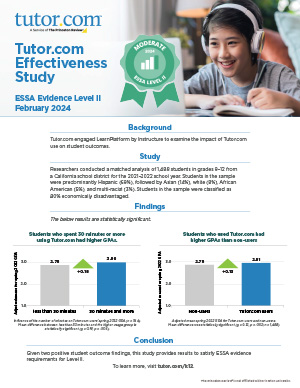 Study Highlights
Study Highlights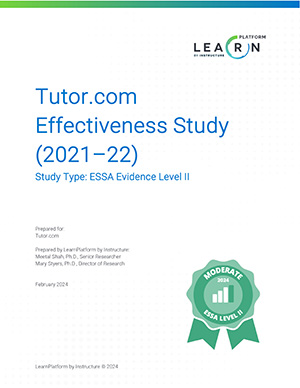 Full Study
Full Study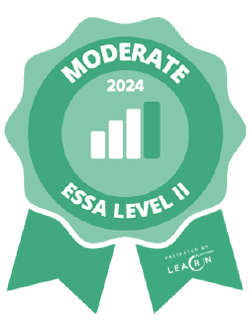 ESSA II Credential
ESSA II Credential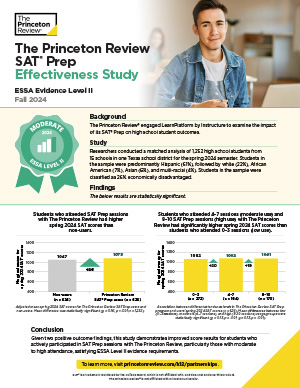 Study Highlights
Study Highlights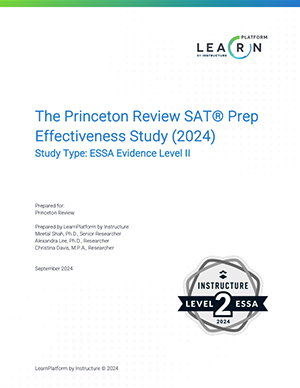 Full Study
Full Study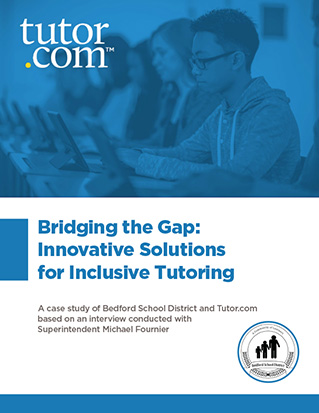 Bridging the Gap: Innovative Solutions for Inclusive Tutoring: A case study of Bedford School District and Tutor.com
Bridging the Gap: Innovative Solutions for Inclusive Tutoring: A case study of Bedford School District and Tutor.com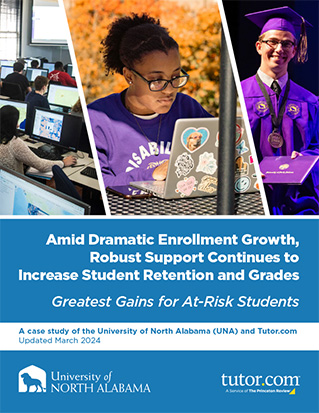 Amid Dramatic Enrollment Growth, Robust Support Continues to Increase Student Retention and Grades
Amid Dramatic Enrollment Growth, Robust Support Continues to Increase Student Retention and Grades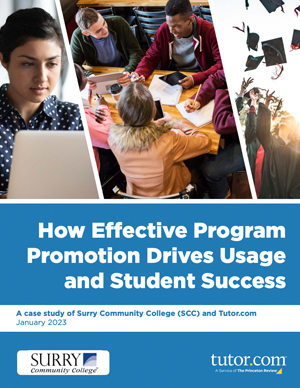 How Effective Program Promotion Drives Usage and Student Success: A case study of Surry Community College
How Effective Program Promotion Drives Usage and Student Success: A case study of Surry Community College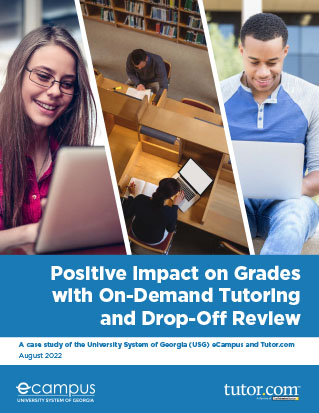 Positive Impact on Grades with On-Demand Tutoring and Drop-Off Review: A Case Study of the University System of Georgia (USG) eCampus and Tutor.com
Positive Impact on Grades with On-Demand Tutoring and Drop-Off Review: A Case Study of the University System of Georgia (USG) eCampus and Tutor.com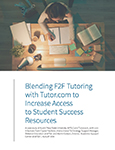 Blending F2F Tutoring with Tutor.com to Increase Access to Student Success Resources: A Case Study of Austin Peay State University and Tutor.com
Blending F2F Tutoring with Tutor.com to Increase Access to Student Success Resources: A Case Study of Austin Peay State University and Tutor.com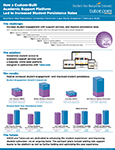 How a Custom-Built Academic Support Platform Led to Increased Student Persistence Rates: A Case Study Snapshot for Southern New Hampshire University and Tutor.com
How a Custom-Built Academic Support Platform Led to Increased Student Persistence Rates: A Case Study Snapshot for Southern New Hampshire University and Tutor.com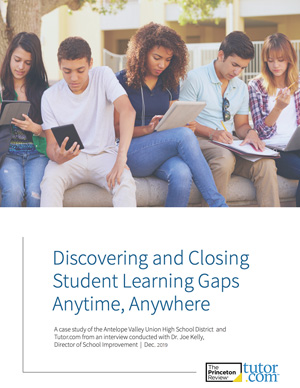 Discovering and Improving Student Learning Gaps Anytime, Anywhere: A Case Study of the Antelope Valley Union High School District and Tutor.com
Discovering and Improving Student Learning Gaps Anytime, Anywhere: A Case Study of the Antelope Valley Union High School District and Tutor.com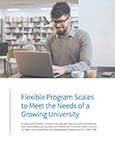 Flexible Program Scales to Meet the Needs of a Growing University: A Case Study of Abeline Christian University and Tutor.com
Flexible Program Scales to Meet the Needs of a Growing University: A Case Study of Abeline Christian University and Tutor.com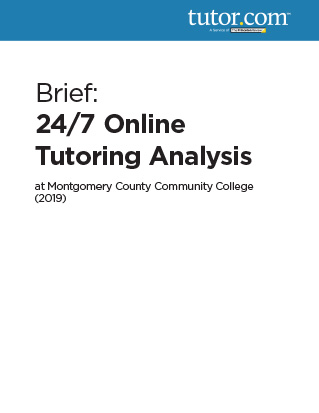 24/7 Online Tutoring Analysis at Montgomery County Community College
24/7 Online Tutoring Analysis at Montgomery County Community College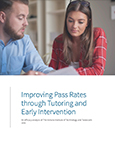 Improving Pass Rates Through Tutoring and Early Intervention: An Efficacy Analysis of the Indiana Institute of Technology and Tutor.com
Improving Pass Rates Through Tutoring and Early Intervention: An Efficacy Analysis of the Indiana Institute of Technology and Tutor.com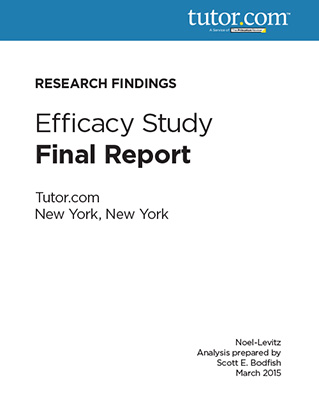 Research Findings: Noel-Levitz Efficacy Study
Research Findings: Noel-Levitz Efficacy Study 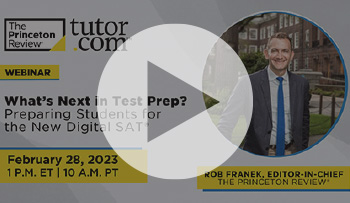 What's Next in Test Prep? Preparing Students for the New Digital SAT®
What's Next in Test Prep? Preparing Students for the New Digital SAT®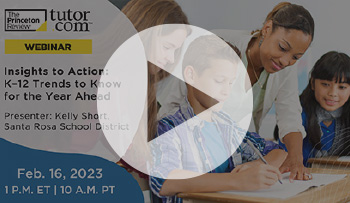 Insights to Action: K–12 Trends to Know for the Year Ahead
Insights to Action: K–12 Trends to Know for the Year Ahead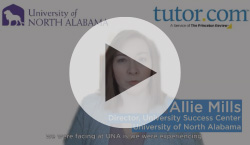 Students in Jeopardy: Strategies to Increase Retention
Students in Jeopardy: Strategies to Increase Retention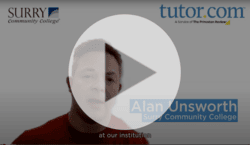 Beyond Program Adoption: Promotion Methods to Drive Student Success
Beyond Program Adoption: Promotion Methods to Drive Student Success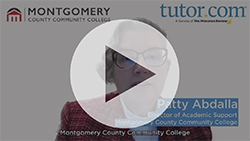 Overcoming STEM Struggles, Improving Student Success and Retention
Overcoming STEM Struggles, Improving Student Success and Retention